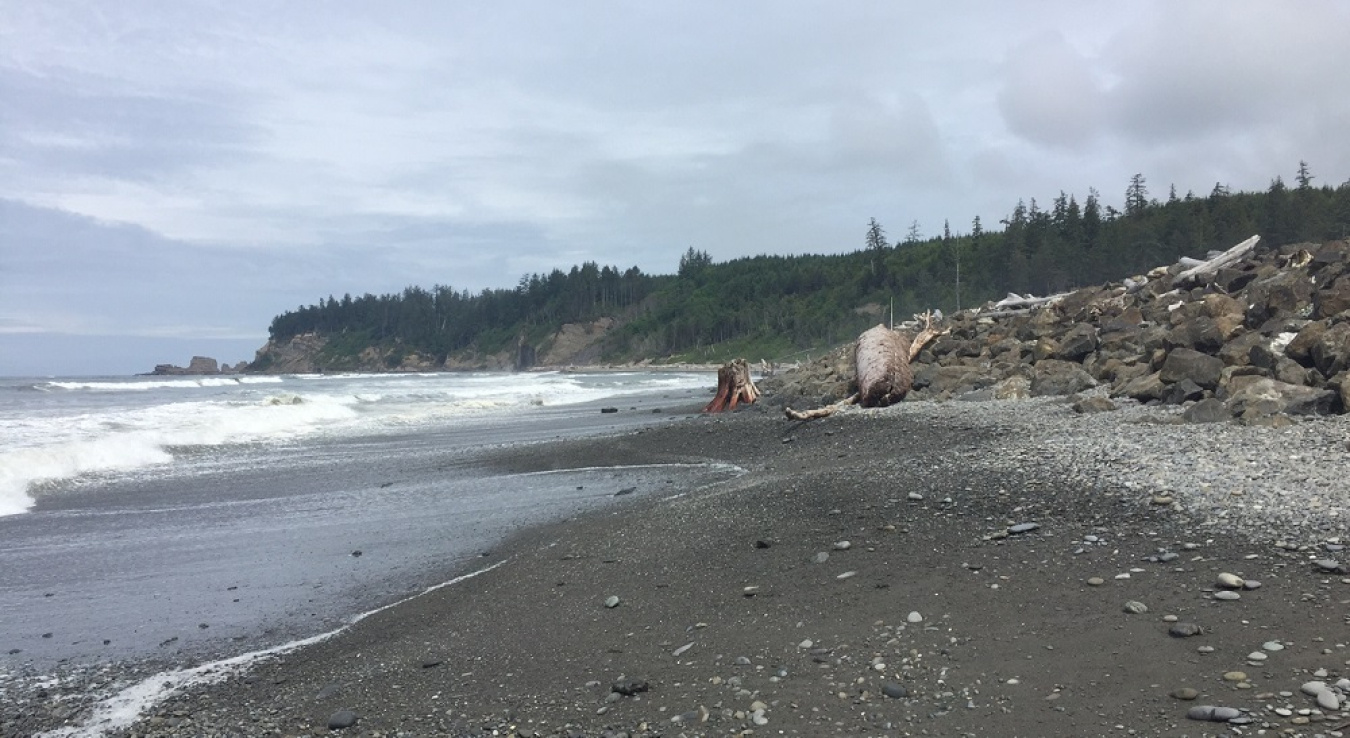The Tribe is working to develop a master plan for the relocation, with funding provided through a grant.
Office of Indian Energy Policy and Programs
June 15, 2016
After two seawall breaches and associated disaster declarations, the Quinault Indian Nation has decided to move two of its villages to safer, more climate-resilient locations. Photo by Eliza Hotchkiss, NREL
For many centuries, the 23-mile stretch of Pacific coastline on Washington's Olympic Peninsula has been home to the Quinault Indian Nation (Tribe). The Quinault Indian Reservation, a triangular tract of land comprising more than 200,000 acres, includes the villages of Taholah, Queets, and Amanda Park. The Reservation’s western boundary is among the few undeveloped shorelines remaining in the United States. An area that was once covered in glaciers and inhabited by woolly mammoths, the Reservation is now being threatened by the impacts of climate change, forcing the Tribe to undertake the arduous task of relocating two villages.
In recent years the Quinault Indian Nation—already vulnerable to potential earthquakes and tsunamis due to its location—has dealt with repeated coastal flooding and erosion impacting its shoreline, landslides and glacial retreat affecting the water supply, warming of rivers impacting historic salmon fishing grounds, and ocean acidification changing marine life, as well as increasing storm frequency and intensity and changes in precipitation. While the entire Quinault Indian Reservation is affected, the villages of Queets and Taholah are most severely affected because of their location along the coast. After two seawall breaches and associated disaster declarations, the Tribe has decided to move the villages to safer, more climate-resilient locations. The Tribe is working to develop a master plan for the relocation, with funding provided through a grant from the U.S. Department of Health and Human Services Administration for Native Americans.

Former Office of Indian Energy Deputy Director David Conrad and National Renewable Energy Laboratory Resilience Lead Eliza Hotchkiss on a site visit to the Quinault Indian Reservation. Photo by Sherry Stout, NREL
The Tribe has already conducted a climate risk assessment and studied the potential inundation zones related to a Cascadia earthquake and an associated tsunami. Stakeholder meetings and community engagement have increased the awareness of risks while also helping to shape the master plan. One of the Tribe’s goals under its master plan is to ensure that the relocated village of Taholah has a resilient energy system. To assist with that goal, the U.S. Department of Energy (DOE) Office of Indian Energy hosted a two-day strategic resilient energy workshop with the Quinault Indian Nation in Taholah, Washington, June 1–2. Office of Indian Energy Deputy Director David Conrad, along with Sherry Stout from DOE’s National Renewable Energy Laboratory (NREL), joined me in leading the workshop.
The workshop focused on what’s currently being planned, how the Quinault Indian Nation is defining resilience, and how a climate-resilient village might look. The relocated Taholah village is being designed as a walkable community that will include a community center, utilize low-impact designs for storm water runoff, and incorporate energy efficiency in homes and public buildings. In addition, to help enhance economic resilience and ensure continued power supply to the remote location during a grid outage, the Tribe is exploring the options for incorporating renewable energy systems and creating a community microgrid.
The support provided by DOE and NREL will include a high-level renewable energy assessment, information on technical options for energy efficiency and resilient energy systems to include in building and community designs, and building plan modeling resulting in recommendations for increasing resiliency longer-term. The resilient relocation project is expected to create new opportunities for the Tribe and supply valuable clean energy to the village and the larger grid. This work builds upon past DOE investments in helping the Quinault Indian Nation explore energy efficiency and renewable energy solutions, including a comprehensive biomass strategic planning project grant in 2011 and a renewable energy feasibility study grant in 2004.
The Quinault Indian Nation is just one example of tribal nations being proactive in mitigating and adapting to the impacts of climate change in order to create more resilient communities for generations to come.
See the U.S. Climate Resilience Toolkit for more examples and details about the Quinault Indian Nation’s plans for village relocation. Visit the Tribe’s website to read the Taholah Village Relocation Master Plan. Check out the Office of Indian Energy’s Energy Resource Library for climate change resources. Learn more about the Office of Indian Energy technical assistance available to Indian tribes.
What are the Key Issues?
Tribal impacts from climate change: Glacial retreat and resultant effects on rivers and salmon fisheries, ocean acidification and hypoxia events, sea level rise, coastal erosion, tidal surge, increasing severity and intensity of storm events occurring with disturbing frequency, and invasion of non-native species. Read more in an Office of Indian Energy report on Tribal Energy System Vulnerabilities to Climate Change and Extreme Weather.
Declared disasters: In March 2014, the Quinault Indian Nation declared a state of emergency after the seawall protecting Taholah was breached by a storm surge that flooded the lower portion of the village. The seawall was repaired as a temporary measure by the U.S. Army Corps of Engineers. In January 2015, the Tribe declared another state of emergency after heavy rains caused flooding, landslides, culvert failures, and washouts that resulted in closed roads and threatened the village wastewater treatment plants (“Deluge Causes Flooding, Mudslides, State of Emergency on Quinault Reservation,” Indian Country Today, Jan. 7, 2015).

